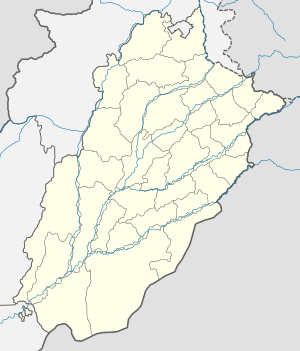Karianwala
Karianwala is a village and tehsil and Gujrat District, Punjab, Pakistan. Documents in local archives indicate that it was founded in 1206–1207.[1] It was the site of a battle in 1780 CE.[2]
Karianwala | |
|---|---|
 Karianwala | |
| Coordinates: 32°45′05″N 74°16′44″E | |
| Country | |
| Province | Punjab |
| District | Gujrat |
| Government | |
| • Tehsil Police Officer | Babar Hassain Bhatti |
| Time zone | UTC+1 (PST) |
According to one proposal, the name "Karianwala" is derived from the Punjabi/Urdu word "Kari", which means a "chain". It was reported that in Karianwala, steel chains were produced, so it has been called "Karianwala" which means "a place where chains are produced".and now it is developing by leaps and bounds.It has 6 branches of different banks,a degree college for boys and a goverment hospital in which great technology equipments are used and have professional and experienced doctors.Now it makes progress by leaps and bounds.
History
The precise origin of Karianwala has been a mystery for the local historians;[1] however, there is evidence that a town settlement was built in the years AD 1206-1207, by a slave known as Saiy Satwan, at the direction of Qutbuddin Aibak, a king of northwest India, who was the first Sultan of Delhi and founder of the Ghulam dynasty (Mamluk Sultanate) of India. During the reign of Akbar, Masami Mahbu settled a base under the name "Akbarabad". Later, the descendants of Masami inhabited Karianwala, and they built other towns in the surrounding area.[1]
A fort, known as Islamgarh Fort, had been constructed at Islamgarh, near to Karianwala. During 1828, Mahaja Ranjit Singh built a mint in the area.[1]
Climate
This City has moderate climate, which is hot in summer and cold in winter. During peak summer, the day temperature shoots up to 50 °C,
Education
There are two specialised government colleges in the city.
The population of the city began to grow quickly at some point in the past century, increasing need for Elementary, Middle, and High Schools. As the government did not (and does not) have a lot of resources to keep up with the demand, some private schools were built along with state schools. Notable schools in the area are 'The Educators' ,'Jinnah Public School' and'Danish International Grammar School & Girls College'.
References
- "Historical sites in Gujrat crumbling". Daily Times. 9 May 2004. p. 7/18. Retrieved 27 October 2012.
- Griffin, Lepel Henry (1865). The Panjab chiefs, historical and biographical notices. T.C. McCarthy. p. 318. OCLC 15033743.
Further reading
- Khan, Sarfraz (2017). Impact of Migration on Education and Health (A Case Study of Karrianwala Village, District Gujrat, Pakistan) (Thesis). Quaid-i-Azam University Islamabad, Pakistan.CS1 maint: ref=harv (link)